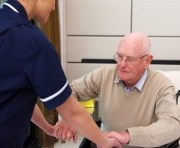VIDEO: Is ‘care’ the missing component in the NHS?
 Today another damning report on nursing care standards has come out of the newly re-invigorated Care Quality Commission (CQC). In unannounced spot checks on care standards for the elderly at 100 NHS hospitals (focussing primarily on whether elderly patients were treated with respect and whether they were getting adequate and appropriate food and drink), they found 55 cases described as ‘alarming’, 35 institutions in need of improvement while 20 were found to be failing seriously.
Today another damning report on nursing care standards has come out of the newly re-invigorated Care Quality Commission (CQC). In unannounced spot checks on care standards for the elderly at 100 NHS hospitals (focussing primarily on whether elderly patients were treated with respect and whether they were getting adequate and appropriate food and drink), they found 55 cases described as ‘alarming’, 35 institutions in need of improvement while 20 were found to be failing seriously.
These finding follow on from earlier, smaller CQC inspections of NHS and private care institutions that found unacceptable levels of care for the elderly. Problems included call bells being deliberately placed out of the reach of patients, staff speaking in a condescending or dismissive way and curtains not being closed properly when patients were on bed pans or having bed baths. Patients who were assessed as needing help with feeding themselves were getting no support and were left to go hungry, while interruptions meant that not all meals were being finished by patients.
In an interview on the Today programme this morning, the Director of Operations at the CQC, Amanda Sherlock pinpointed a lack of leadership as the primary problem – at all levels from hospital boards down to clinical nurse leadership at the ward level. The Royal College of Nursing has argued that falling care standards in the NHS have been due to nurses being overstretched and working on understaffed units, but the CQC says this does not explain the systematic failure to care for even the most basic needs.
I find it hard to be critical of my fellow nurses, because I know so many are giving good care and working in incredibly stressful situations with inadequate staffing. But it is clear from this, and countless other examples that nursing care standards are failing badly in many parts of our health service. Even the Royal College of Nursing has come out and admitted that not only are the wards increasingly staffed by unregulated care assistants rather than trained nurses, but that increasingly newly qualified nurses are not up to the job because they do not have the clinical skills and the ethos of care. These failures of the most basic care highlighted by the CQC show that affording value and dignity to the sick individual, helping them manage daily tasks like eating and washing with the utmost consideration and respect is what is missing.
And as more and more of this care is given by untrained care assistants, it creates an institutional assumption that such core care is not part of nursing practice. Trained nurses are moved to more technical and bureaucratic roles, away from basic care, giving out the subliminal message that such care is of low priority.
It is often assumed that care and compassion are universal human traits, and being innate, we do not need to teach them. Which is why so many people are baffled that ‘care and compassion’ are forming parts of the nursing curriculum these days. Surely, it is argued, we are in bad place when we need to teach this? But this is a naïve, cultural blindness here in the West, long informed by (mostly Christian) values that place care for the vulnerable at the heart of our interactions with the sick, frail and vulnerable. Care and compassion are primarily virtues – qualities of character and action that are learnt and intentional rather than innate and universal.
Yes, we have all met ‘natural nurses’ – people who seem to know how to care for people instinctively. However, look deeper and you will find women and men who have had caring modelled to them by family and friends in their formative years. It is by working with more experienced colleagues that a student nurse learns not only the technical skills and science of nursing, but also absorbs the virtues and ethos of compassionate care that puts the patients’ needs at the centre of their practice.
Christians have always been urged to see the other in need as Jesus himself – to care for those in need as if we were caring for him. It is an attitude that puts the person in need at the centre, rather than ourselves – our own needs, comfort, or indeed career advancement. I would argue that this virtue of selfless care has been absorbed by osmosis into our culture in the past, such that to many it now seems natural and instinctive. Sadly, it is this virtue that appears to be being eroded in modern British society.
In the same interview on Today, Health Secretary Andrew Lansley conceded that a target driven, output focussed NHS culture was in part to blame – encouraging staff to be more focussed on achieving set outcomes and targets than in caring for each patient as a human being in need. And this is a failing of our wider culture, which is more and more concerned with efficiency and consumer choice than on more basic human values of dignity and selfless care for the other. So, if care and compassion are increasingly not being modelled at any level in our health service and wider society, is it any wonder that they are not forming part of the core of nursing?
How do we change this? Yes, good standards and systems are important, and inspections by groups like CQC keep us on our toes, but there is no easy management approach to solve this. I would argue that it is only by bucking the culture, creating different tone, daring to be unpopular by going he extra mile for our patients rather than following the path of least resistance and greatest ‘efficiency’, and leading by example that we can start to change things.
Good nurses and doctors have always done this, and still are; they are the role models that we need to teach the next generation how to truly care.











Leave a Reply
Want to join the discussion?Feel free to contribute!